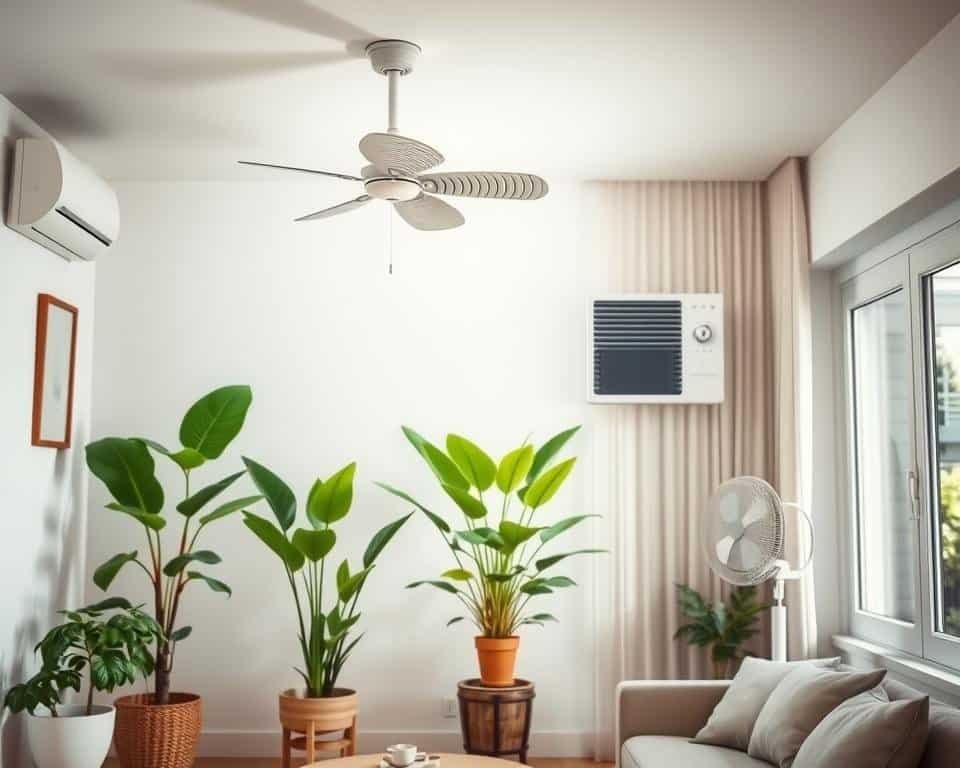Rooms without proper ventilation can lead to poor indoor air quality. This is a big concern for our health and wellbeing. It’s important to find ways to improve the air quality in these rooms.
Improving indoor air quality is key. There are many ways to do this, including using room ventilation solutions. Without ventilation, rooms can become unhealthy. This article will help you understand the importance of ventilation and how to improve air quality in rooms without it.

Finding the right solution to improve indoor air quality is crucial. This article will look at different options, from simple to complex. By understanding ventilation’s importance and exploring solutions, you can make your space healthier.
Understanding Poor Ventilation Signs and Risks
Poor ventilation solutions can cause health problems like respiratory issues and mould growth. It’s key to spot signs like musty smells and dampness early. Fixing these issues can greatly improve air quality.
Common signs of poor air include:
- Stale or stuffy air
- Mould and mildew growth
- Musty odours
- Respiratory problems
To tackle these issues, enhancing airflow is crucial. This can be done with fans, open windows, or ventilation systems.
Knowing the signs and risks of poor air helps us act fast. This improves air quality at home and work.
Good air ventilation remedies are key to keeping air clean. Simple steps like using fans or installing systems can help. These actions reduce health risks and make spaces healthier.
Quick Solutions for Immediate Ventilation Improvement
There are many ways to improve ventilation in a room. You can create cross ventilation, use portable fans, and try temporary dehumidification. These natural air circulation methods make the air healthier and more comfortable to breathe. For example, opening windows on opposite sides of the house can help.
Portable fans are great for improving air flow in areas with little natural breeze. Temporary dehumidifiers also help by reducing moisture in the air. This makes the air feel cooler and more comfortable. These solutions are perfect for tiny houses where space is tight.
- Open windows and doors to create cross ventilation
- Use portable fans to circulate air and improve ventilation
- Implement temporary dehumidification methods to reduce moisture levels
By using these best ventilation techniques and ventilation tips for home, you can greatly improve indoor air quality. This makes your living space healthier. Always choose natural air circulation methods for the best ventilation and comfort.
What to Do if a Room Has No Ventilation: Long-term Solutions
For a lasting fix to ventilation problems in room, long-term room ventilation solutions are key. They greatly improve indoor air quality and make homes healthier. Here, we explore long-term fixes for rooms without ventilation.
Installing Mechanical Ventilation Systems
Installing mechanical ventilation systems is a top choice. They ensure fresh air flows in and stale air goes out. This is great for tiny house ventilation solutions where space is tight.
Adding Structural Ventilation Points
Adding windows or vents is another smart move. It boosts indoor air quality and lets air in naturally.
Smart Ventilation Technologies
Smart ventilation tech offers a lasting solution to ventilation problems in room. It tracks air quality and adjusts ventilation. This is a top way to improve indoor air quality and ensure a healthy home.
Natural Ventilation Enhancement Techniques
Natural air circulation methods can greatly improve indoor air quality. They are very effective in small spaces, like tiny houses. By using natural ventilation, people can cut down on mechanical systems and live healthier.
There are many ways to boost airflow in a room. For instance, bigger windows or skylights let in more natural light and air. Passive airflow solutions, like solar chimneys or windcatchers, also help move air without needing machines.
Plant-based air purification is another remedy. Plants like peace lilies or spider plants clean the air. Adding these plants to a room can make it a natural air filter. Here are some tips for using plants to improve airflow:
- Put plants near windows for more light and air
- Choose plants that clean the air to improve quality
- Use plants to make your room look good and feel fresh
Using natural air circulation and plants can make your home healthier and greener. These methods help keep the air clean and reduce the need for machines.
Professional Ventilation Services and Costs
Thinking about room ventilation solutions? It’s key to look at the costs and benefits of getting a pro to install it. If your room lacks ventilation, a professional can offer a full solution. They’ll check your home’s needs and suggest the best ventilation tips for home.
A pro can help pick the right system for your home. This might mean installing mechanical systems, adding ventilation points, or using smart tech. With their help, you can be sure the job is done right and safely.
- Improved indoor air quality
- Increased energy efficiency
- Enhanced home comfort
Choosing a professional ventilation service? Look at their experience, reputation, and prices. Getting a pro can make your home healthier and more comfy. It might even boost your home’s value.
Conclusion
Keeping the air fresh is key to a healthy home, big or small. Using tiny house ventilation solutions, best ventilation techniques, and ways to improve indoor air quality helps a lot. This makes your home more comfortable and healthy.
This article has shown many ways to solve ventilation problems. From using natural airflow to installing smart systems, there are many options. Homeowners can pick the best one for their home by thinking about their needs and maybe getting help from experts.
Good air flow is more than just comfort. It’s about keeping you and your family healthy. So, start making your home a better place to breathe today.
FAQ
What are the signs of poor ventilation in a room?
Poor ventilation shows as mould and mildew growth, musty smells, and breathing issues. It’s crucial to fix this to avoid health problems.
What are some quick solutions for improving ventilation in a room?
Quick fixes include making cross ventilation, using fans well, and temporary dehumidifiers. These methods quickly boost air quality indoors.
What are the long-term solutions for a room with no ventilation?
Long-term fixes include installing mechanical systems, adding ventilation points, and smart tech. These solutions offer a lasting air quality improvement.
What are some natural ventilation enhancement techniques?
Natural methods include modifying windows, passive airflow, and plants for air purification. They’re great for tiny houses and small spaces.
What are the benefits of hiring a professional for ventilation services?
Professionals bring effective systems and expert advice. Costs vary, but better air quality is worth it in the long run.




Leave a reply